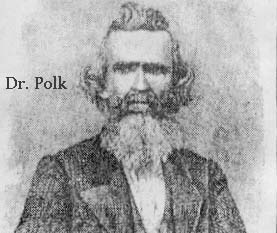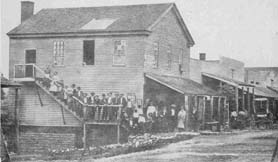Danville Theological Seminary contends with the aftermath of Perryville Battle
By Stuart W. Sanders
In 1853, the Presbyterian Theological Seminary of Kentucky, also known as the Danville Theological Seminary, opened its doors. The Rev. Robert J. Breckinridge and Centre College president John C. Young, leaders among Kentucky Presbyterians, founded this school in Danville for the purpose of training clergy from across the region.
The seminary operated on the Centre College campus until 1854, when the school moved into several structures located at the present site of Constitution Square (at the corner of Main and First streets). The main building, a brick structure nearly 110 feet long by 37 feet wide, was central to Kentucky history. Constructed when Kentucky was still part of Virginia, it served as the first state house of Kentucky. Here, the Commonwealth's first constitution was adopted.
Alterations of this two-story structure for the main seminary building required dividing it into two chapels and fifteen other rooms. This site, and other structures located on the extensive grounds, provided classroom space and dormitory facilities for the students. Prior to the Civil War the seminary had boasted nearly forty students per year, but, like many local institutions, the seminary could not rise above the economic hardships incurred by the Battle of Perryville.
When Confederate armies invaded Kentucky in the summer of 1862, they commandeered the seminary to house sick Southern soldiers. The situation worsened when, on October 8, 1862, the Battle of Perryville left more than 7,500 troops killed and wounded. In its aftermath, area communities cared for wounded troops, and Danville's spacious seminary became a main hospital site. Two additional buildings on the grounds, a five-room frame structure and a small brick building, also housed patients. Tents were scattered across the lawn, and residents frequently saw recovering soldiers sitting on benches placed under trees on the property.
Most area hospitals housed either Northern or Southern patients, yet wounded and sick from both sides were jammed into the main seminary building. Rebel surgeons received permission to remain in town to care for wounded Confederates who were, nevertheless, prisoners of war. Local housekeeper Mary Harris, who nursed the injured and wrote letters home for many of the soldiers, commented, "I was in that building every day, and I bathed the brow of many a soldier in there, both Federal and Confederate."
The enemy troops did not intermingle. Union troops piled into the west side of the structure, while the Southerners crammed into the eastern end. Danville tailor Abraham Barker had a theory for this separation. He believed that "they had them in different sides to keep them, I reckon, from fighting . . ."
When Dr. A. N. Read of the United States Sanitary Commission visited five of the seminary rooms in mid October, he noted that 79 wounded were packed into them. All of these patients had beds (unlike many of the Danville hospitals) and twenty-six nurses provided care for them. When Read returned to tour the entire site at the end of the month, he found that the seminary was "occupied half by federal and half by rebel sick. Of the federal there were 95 in two rooms . . . [with] men generally on bunks, no bedsacks, no pillows, some without blankets; their clothing, such as they had worn in the field [was] generally much soiled; cooking done in the open air in a few camp kettles. Confederates in ten rooms . . . Their condition similar to that of the federals, except things were more filthy, their clothing much poorer."
The sick likely suffered from the common 19th century military ailments: typhoid, pneumonia, and dysentery. Furthermore, many of the wounded were in critical condition. Read reported that those in the seminary "were all badly wounded." In addition, Mary Harris testified, "They were all to pieces-some of them shot to pieces, some of them with shell and some with bullets; there were amputations." Dr. Read believed that of the Danville hospitals, including the courthouse and most churches, the seminary was "the best of the series," because all of the other hospitals were "far too much crowded."
"When this Seminary property was finally vacated as a hospital, it was pretty badly done up, very much abused," reported Danville citizen E. E. Akin. "Everything was out of order . . . I didn't see anything that was in order, anything that hadn't been very roughly used. The walls knocked [in], and plastering off, and [wall]paper injured, and windows broken." Mary Harris noted that "The fencing was all gone, it was fenced around, and that was all gone. The walls and windows were defaced. There were a good many lights out." She remarked that this fencing "was burned up for fuel. I saw [the troops] tearing it down and burning it. That was a matter of necessity to the soldiers; they had to keep warm someway."
The smaller buildings on the property also sustained damage. Akin testified that "The frame building was injured. The kitchen floor looked as if they had been splitting kindling on it. The windows were smashed, and one door was off." All of the buildings required repainting and new wallpaper. Because of the occupation, the seminary was unable to use any of the buildings for nearly two years. In fact, the seminary was the last Danville hospital to be cleared of soldiers. According to a claim filed after the Civil War, this hospital didn't close until 1864, more than a year after the Battle of Perryville.
The Civil War caused severe economic damage to the institution. In 1907, the seminary attempted to get $5,000 for the damages, but the claim was never paid. By this time, however, the school had merged with the Louisville Presbyterian Seminary. Because of this conflict, there was no longer a theological seminary in Danville. The main seminary building eventually deteriorated and was razed. In 1940, the site became Constitution Square State Historic Site, reminding visitors, thereby, of the site's earlier role in Kentucky's history.
Stuart W. Sanders is director of the Perryville Battlefield Preservation Association. For more information, see www.perryville.net

